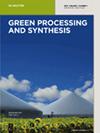Synthesis of Lawsonia inermis-encased silver–copper bimetallic nanoparticles with antioxidant, antibacterial, and cytotoxic activity
IF 3.8
4区 工程技术
Q2 CHEMISTRY, MULTIDISCIPLINARY
引用次数: 0
Abstract
The extract of the medicinal plant Lawsonia inermis, known as henna, was employed to synthesize silver–copper bimetallic nanoparticles (Ag–Cu NPs) in a unique, efficient, and cost-effective method. The shape, size, and structural features of synthesized Ag–Cu NPs were determined by ultra–visible spectroscopy, Fourier transform infrared spectroscopy, X-ray diffractometer, field emission scanning electron microscopy, transmission electron microscopy, and energy dispersive X-ray spectroscopy methods. The rod-shaped Ag–Cu nanoparticles, averaging 41.66 ± 17.18 nm in size, synthesized from L. inermis, exhibited potent antioxidant activity by inhibiting 2,2-diphenyl-1-picrylhydrazyl and 2,2′-azinobis (3-ethylbenzothiazoline-6-sulfonic acid) free radicals. They also displayed significant antibacterial effects against Pseudomonas aeruginosa (28 mm), Staphylococcus aureus (27 mm), Bacillus cereus (26 mm), and Escherichia coli (24 mm). Additionally, these nanoparticles induced notable morphological changes in cancer cells and demonstrated promising cytotoxicity against MDA-MB-231 tumor cells (IC50 = 37.40 µg·mL−1). However, they exhibited biotoxicity in Artemia nauplii, resulting in mortality rates ranging from 3.0% to 32.5%. The LC50 and LC90 values recorded for a 48-h exposure were 1.51 mg·L−1 and 2.59 mg·L−1, respectively. These findings highlight the potential application of L. inermis-derived Ag–Cu NPs in pharmacology and bio-nanomedicine.具有抗氧化、抗菌和细胞毒性活性的银铜双金属纳米粒子的合成
本研究采用一种独特、高效、经济的方法,从被称为指甲花的药用植物 "Lawsonia inermis "中提取物合成银铜双金属纳米粒子(Ag-Cu NPs)。通过超可见光谱、傅立叶变换红外光谱、X 射线衍射仪、场发射扫描电子显微镜、透射电子显微镜和能量色散 X 射线光谱等方法测定了合成的银铜纳米粒子的形状、尺寸和结构特征。从鳞茎中合成的平均粒径为 41.66 ± 17.18 nm 的棒状银铜纳米粒子通过抑制 2,2-二苯基-1-苦基肼和 2,2′-偶氮双(3-乙基苯并噻唑啉-6-磺酸)自由基而表现出强大的抗氧化活性。它们还对铜绿假单胞菌(28 mm)、金黄色葡萄球菌(27 mm)、蜡样芽孢杆菌(26 mm)和大肠杆菌(24 mm)具有明显的抗菌效果。此外,这些纳米粒子还能诱导癌细胞发生显著的形态变化,并对 MDA-MB-231 肿瘤细胞表现出良好的细胞毒性(IC50 = 37.40 µg-mL-1)。然而,它们在蒿甲虫中表现出生物毒性,导致死亡率从 3.0% 到 32.5%不等。暴露 48 小时的 LC50 和 LC90 值分别为 1.51 mg-L-1 和 2.59 mg-L-1。这些研究结果突显了鳞栉水母衍生的银铜氧化物(Ag-Cu NPs)在药理学和生物纳米医学中的潜在应用。
本文章由计算机程序翻译,如有差异,请以英文原文为准。
求助全文
约1分钟内获得全文
求助全文
来源期刊

Green Processing and Synthesis
CHEMISTRY, MULTIDISCIPLINARY-ENGINEERING, CHEMICAL
CiteScore
6.70
自引率
9.30%
发文量
78
审稿时长
7 weeks
期刊介绍:
Green Processing and Synthesis is a bimonthly, peer-reviewed journal that provides up-to-date research both on fundamental as well as applied aspects of innovative green process development and chemical synthesis, giving an appropriate share to industrial views. The contributions are cutting edge, high-impact, authoritative, and provide both pros and cons of potential technologies. Green Processing and Synthesis provides a platform for scientists and engineers, especially chemists and chemical engineers, but is also open for interdisciplinary research from other areas such as physics, materials science, or catalysis.
文献相关原料
| 公司名称 | 产品信息 | 采购帮参考价格 |
|---|
 求助内容:
求助内容: 应助结果提醒方式:
应助结果提醒方式:


